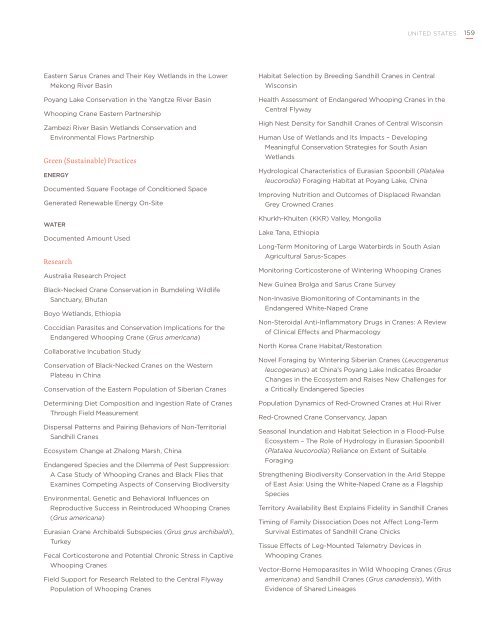celebrates
arcs_2015
arcs_2015
Create successful ePaper yourself
Turn your PDF publications into a flip-book with our unique Google optimized e-Paper software.
UNITED STATES<br />
159<br />
Eastern Sarus Cranes and Their Key Wetlands in the Lower<br />
Mekong River Basin<br />
Poyang Lake Conservation in the Yangtze River Basin<br />
Whooping Crane Eastern Partnership<br />
Zambezi River Basin Wetlands Conservation and<br />
Environmental Flows Partnership<br />
Green (Sustainable) Practices<br />
ENERGY<br />
Documented Square Footage of Conditioned Space<br />
Generated Renewable Energy On-Site<br />
WATER<br />
Documented Amount Used<br />
Research<br />
Australia Research Project<br />
Black-Necked Crane Conservation in Bumdeling Wildlife<br />
Sanctuary, Bhutan<br />
Boyo Wetlands, Ethiopia<br />
Coccidian Parasites and Conservation Implications for the<br />
Endangered Whooping Crane (Grus americana)<br />
Collaborative Incubation Study<br />
Conservation of Black-Necked Cranes on the Western<br />
Plateau in China<br />
Conservation of the Eastern Population of Siberian Cranes<br />
Determining Diet Composition and Ingestion Rate of Cranes<br />
Through Field Measurement<br />
Dispersal Patterns and Pairing Behaviors of Non-Territorial<br />
Sandhill Cranes<br />
Ecosystem Change at Zhalong Marsh, China<br />
Endangered Species and the Dilemma of Pest Suppression:<br />
A Case Study of Whooping Cranes and Black Flies that<br />
Examines Competing Aspects of Conserving Biodiversity<br />
Environmental, Genetic and Behavioral Influences on<br />
Reproductive Success in Reintroduced Whooping Cranes<br />
(Grus americana)<br />
Eurasian Crane Archibaldi Subspecies (Grus grus archibaldi),<br />
Turkey<br />
Fecal Corticosterone and Potential Chronic Stress in Captive<br />
Whooping Cranes<br />
Field Support for Research Related to the Central Flyway<br />
Population of Whooping Cranes<br />
Habitat Selection by Breeding Sandhill Cranes in Central<br />
Wisconsin<br />
Health Assessment of Endangered Whooping Cranes in the<br />
Central Flyway<br />
High Nest Density for Sandhill Cranes of Central Wisconsin<br />
Human Use of Wetlands and Its Impacts – Developing<br />
Meaningful Conservation Strategies for South Asian<br />
Wetlands<br />
Hydrological Characteristics of Eurasian Spoonbill (Platalea<br />
leucorodia) Foraging Habitat at Poyang Lake, China<br />
Improving Nutrition and Outcomes of Displaced Rwandan<br />
Grey Crowned Cranes<br />
Khurkh-Khuiten (KKR) Valley, Mongolia<br />
Lake Tana, Ethiopia<br />
Long-Term Monitoring of Large Waterbirds in South Asian<br />
Agricultural Sarus-Scapes<br />
Monitoring Corticosterone of Wintering Whooping Cranes<br />
New Guinea Brolga and Sarus Crane Survey<br />
Non-Invasive Biomonitoring of Contaminants in the<br />
Endangered White-Naped Crane<br />
Non-Steroidal Anti-Inflammatory Drugs in Cranes: A Review<br />
of Clinical Effects and Pharmacology<br />
North Korea Crane Habitat/Restoration<br />
Novel Foraging by Wintering Siberian Cranes (Leucogeranus<br />
leucogeranus) at China’s Poyang Lake Indicates Broader<br />
Changes in the Ecosystem and Raises New Challenges for<br />
a Critically Endangered Species<br />
Population Dynamics of Red-Crowned Cranes at Hui River<br />
Red-Crowned Crane Conservancy, Japan<br />
Seasonal Inundation and Habitat Selection in a Flood-Pulse<br />
Ecosystem – The Role of Hydrology in Eurasian Spoonbill<br />
(Platalea leucorodia) Reliance on Extent of Suitable<br />
Foraging<br />
Strengthening Biodiversity Conservation in the Arid Steppe<br />
of East Asia: Using the White-Naped Crane as a Flagship<br />
Species<br />
Territory Availability Best Explains Fidelity in Sandhill Cranes<br />
Timing of Family Dissociation Does not Affect Long-Term<br />
Survival Estimates of Sandhill Crane Chicks<br />
Tissue Effects of Leg-Mounted Telemetry Devices in<br />
Whooping Cranes<br />
Vector-Borne Hemoparasites in Wild Whooping Cranes (Grus<br />
americana) and Sandhill Cranes (Grus canadensis), With<br />
Evidence of Shared Lineages


